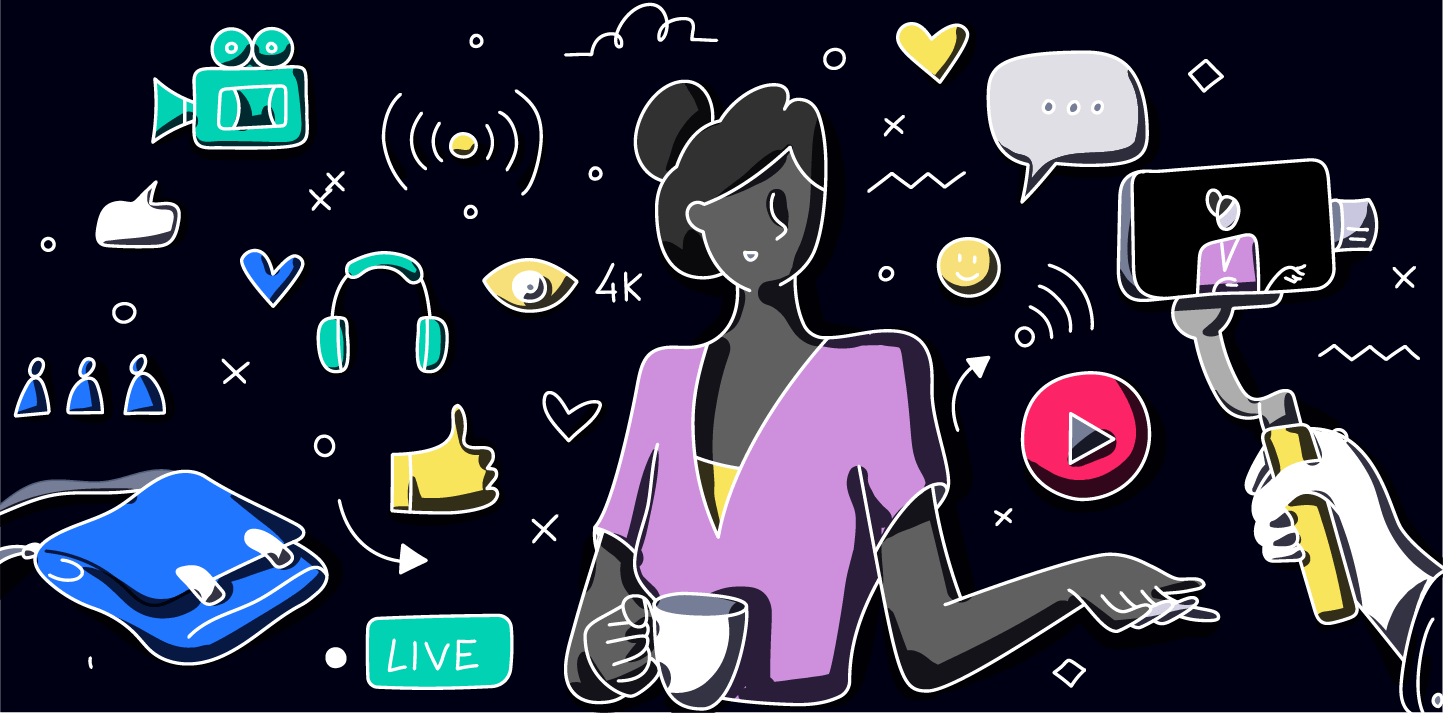Ten+ years since its inception, you’ve heard plenty about the rise of Influencer Marketing — you’ve likely even built relationships with a few influencers to champion your brand or key service offerings. But, like so many of the changes ushered in by the pandemic, Influencer Marketing has transformed rapidly in just over a year.
Let’s take a look at some of the major shifts in working with influencers and things to be mindful of as you build them into brand strategies.
The state of influencer marketing in 2021.
This year, brands are estimated to spend $13.8 billion on influencer content, a marked increase over its 2020 figure of $9.7 billion. According to a study by Klear, influencers posted 38.1 brand-sponsored “stories” to their social media channels each week in 2020; that same study found that users were viewing that sponsored content at a 57% increase from 2019 to 2020. And, of the brands surveyed by Influencer Marketing Hub, 75% said they intended to focus more on influencers as part of their future advertising strategies.
What’s driving the rise?
Three big ideas:
- The pandemic. Turns out keeping people inside, attached to screens more than ever, accelerated several digital trendlines, including engagement with digital brands and personalities. Influencers with a constant stream of relatable, charismatic content became a release—even a temporary replacement—for in-person interaction in the last year. Now that consumers are hooked on the content those influencers deliver, we expect to see this level of engagement to continue. As digital advertising and social media algorithms serve more relevant content based on online behavior, we expect consumers to continue to follow highly relevant content producers who are aligned with their lifestyles interests.
- The erosion of trust in institutions. We’ve been blogging for over a year now about growing disillusionment with institutions like government, media, religious bodies, etc. This lack of trust has created an opening for brands and influencers delivering clear, consistent messages about products and services that have an immediate, tangible impact in the lives of the communities they serve. Meanwhile, the psychology of influencer / user-generated trust is now well documented. In an era where Amazon reviews and word-of-mouth from friends and family carry heavy weight, it’s no surprise user-generated content from influencers who position themselves as everyday authorities in a specific subject has been elevated to leading sources of information. This dynamic isn’t going anywhere.
- Interest affinity > brand affinity. Consumers have been exposed to influencers and brand deals long enough to spot sponsored content when they see it, be it an #Ad hashtag or overt hawking of products. But, if we’ve learned anything in the last few years, influencers have learned how to work with brands to tastefully promote a product in their own voice, on their own creative terms—and consumers are here for it. Influencers are highly protective of their own personal brands, often dependent on their commitment to their following and delivering an authentic experience through content. They have a vested interest in both running sponsored content while tailoring it as a fun, funny or natural extension of the passions they communicate to their followings. This approach is what draws consumers in — they don’t feel like they’re being sold, they feel like they’re hearing a friend give them honest advice, even if they disclose certain products are part of a brand deal. Consumers indicate influencer ads are more “personalized and “memorable,” and it’s impacting the bottom line for product conversion rates.
An example, you ask?
Meet @devinsupertramp, a YouTuber with 5+ million subscribers who posts lifestyle videos of active living and stunts. He was approached by Subaru for their #MeetAnOwner campaign to engage fellow millenials. Here’s what he did.
Why is this effective? Instead of building a video inside a car talking about facts and figures, Devin built an ad for his audience of fans. Devin made this video leaning on the emotional aspect of ownership by staying on-brand to the content his followers love. Subaru trusted him to know his audience and stay in his lane.
Tips for building an influencer program.
Are you already working with influencers? Ready to engage some? Here’s some advice, whether you’re a seasoned vet or just starting out.
- Make sure it’s a natural fit. Getting into the influencer marketing space requires a lot more than merely picking an online personality at random and reaching out to them. It’s about finding the right influencer for your brand. Before deciding on an influencer, you’ll want to ask some basic questions. What sort of outreach do you want? Do you want sponsored posts, or something more involved and creative? What kind of tone do you want the sponsored content to adopt? To get started finding the right influencer for your product or brand, companies can search databases like Alexa and Upfluence to find influencers based on audience demographic, engagement statistics and more.
- Carefully vet your influencers. Once you’ve narrowed your specifications, you’ll want to be sure you actually do your research: Follow the influencers you’re interested in working with, monitor their content and make sure it embodies the attitude and aesthetic you’re looking for. There are obvious upsides to hiring influencers for marketing purposes, not least because they come with built-in audiences, but there can be pitfalls. The fact is many influencers aren’t surrounded by a staff of helpers performing full-time PR damage control, and some have seen the more unsavory elements of their private lives suddenly becoming public. If your product is represented by an influencer with negative baggage, your product will likely be damaged by sheer proximity.
- Consider going “micro.” More and more influencer campaigns are revolving around “micro” influencers, investing in smaller personalities who have a few thousand followers and specialize in more niche, regional or hyper-specific content — an influencer in San Diego whose specialty is vegan cooking tips, for instance, or the popular Instagram account in our hometown, SpokaneEats.
- Aim for long-lasting relationships. Once you’ve settled on an influencer and have agreed upon terms, it’s in your best interest to work with them on more than one campaign. This creates a continuity and consistency within your branding and cements a connection in potential customer’s minds between their favorite influencer and your brand. Work with the influencers to determine how often you want them to post, and how much creative freedom you want to allow. “Brand relationships seem to be moving more toward ongoing ambassadorships and multiple posts,” explains beauty influencer Ramona Jones. “Brands are having a direct relationship with influencers even when working on campaigns through an agency.”Make sure you’re not treating them like disposable commodities, either. Word gets around amongst influencers about which brands are the best and worst to work with, and there are now apps, websites and social media accounts that catalogue the slights and indignities that influencers have experienced (as detailed in this recent New York Times article). Don’t be one of the so-called “brands behaving badly.”
- Build a custom content program with influencers. These relationships are especially important when it comes to creating sponsored content that actually feels authentic. Studies have shown that users respond more positively to ad content that seems organic and genuine, and when the influencer really seems to know and like the products they’re advertising. Relatable, approachable copy — say, a personal anecdote about how and why they use the products — along with an eye-catching photo or video of a trusted influencer using said product is a great way to boost sponsored content. (Of course, influencers should always disclose which of their posts are sponsored, and whether or not they received compensation.) As an example, the wellness brand Healthish began its influencer marketing campaign by sending out free samples of new products to relevant health and fitness influencers, and then monitored the sponsored posts to determine which influencers were inspiring the most engagement. From there, they could determine which influencers were best representing their brand. Brands may also want to consider an ambassador program, wherein the influencers you hire are essentially walking billboards for your brands. If an influencer’s interests align with your brand’s, it’s a mutually beneficial partnership.
- Set clear expectations for how you measure and report on influencer engagement. As with any marketing tactic, your strategy is only as solid as the metrics you can measure it by. The good news is Influencers use programs that provide solid reporting on outputs and outcomes, including traffic driven from their content to unique landing pages or online points of conversion. At the beginning of your engagement with any influencer, inquire about the level of reporting they offer and set expectations for the KPIs you’re interested in measuring with mutual reporting from them. They should also be able to offer a baseline of typical engagement with their content and conversion activity they push to sponsors.
Influencer marketing is only going to take a bigger piece of the marketing pie in the years to come — if you haven’t jumped in yet, now is definitely the time for a strategic discussion about the influencers you could identify and activate in support of your annual goals. Drop us a line if you’d like to chat more about it!

